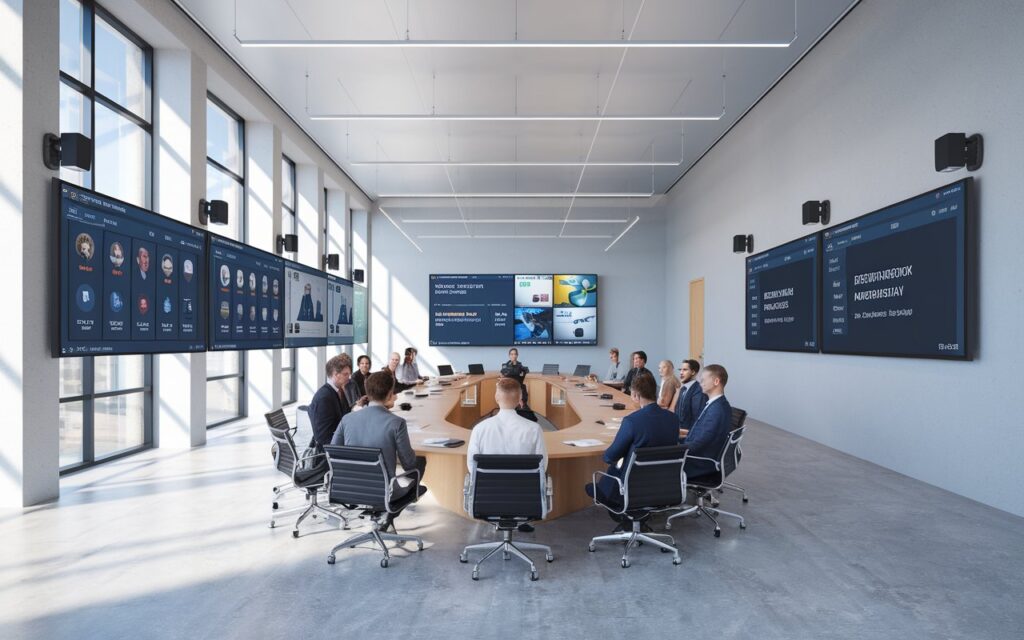The Future of Visual AI in the AV Industry: Trends and Predictions
The Future of Visual AI in the AV Industry: Trends and Predictions

The AV industry has always been at the forefront of innovation, blending technology with creativity to deliver compelling experiences. With the rise of Artificial Intelligence (AI), especially visual AI, the industry is poised for another transformative leap. Visual AI is revolutionizing how we interact with AV systems, enhancing both user experience and operational efficiency. In this blog, we’ll explore the future of visual AI in the AV industry, focusing on key trends and predictions that are likely to shape its evolution.
1. Trend: Enhanced User Experiences Through Intelligent Displays
Visual AI is already enhancing user experiences through intelligent displays that adapt to their environment. These smart displays utilize AI algorithms to adjust brightness, contrast, and color balance based on ambient lighting conditions, making visuals more vivid and engaging. In the future, we can expect these displays to become even more intuitive, responding to user emotions and preferences in real-time.
For instance, AI-powered displays in retail environments could dynamically change content based on a shopper’s demographic profile, facial expressions, or even the time of day. In corporate settings, these displays could enhance meetings by automatically identifying speakers, focusing on key visual elements, and providing real-time translations or annotations.
2. Trend: Advanced Video Analytics for Smarter AV Solutions
Another trend reshaping the AV industry is the integration of advanced video analytics. Visual AI can analyze video feeds in real-time to provide insights that were previously unattainable. In security and surveillance, for example, AI can detect unusual behavior, identify potential threats, and alert security personnel instantaneously.
In the coming years, we will likely see more advanced applications of video analytics in various sectors. In education, for instance, AI could analyze students’ engagement levels during online or hybrid classes, helping educators adjust their teaching methods accordingly. In the events and entertainment industries, visual AI could be used to gauge audience reactions and optimize content delivery in real-time.
3. Prediction: The Rise of Autonomous AV Systems
The future of visual AI in the AV industry points towards the development of autonomous AV systems. These systems could leverage AI to manage, monitor, and optimize their operations without human intervention. Imagine an AI-powered conference room that can automatically set up video conferencing equipment, adjust lighting, and start a meeting at a scheduled time based on calendar integrations.
Moreover, autonomous AV systems could use visual AI to detect faults or inefficiencies in equipment and proactively suggest maintenance or adjustments. This capability would significantly reduce downtime and enhance operational efficiency across various AV applications, from corporate environments to large-scale public installations.
4. Trend: Personalized Content Delivery Through AI-Driven Insights
Personalization is becoming a critical aspect of the AV industry, and visual AI is playing a significant role in making it possible. AI algorithms can analyze user behavior, preferences, and interactions with AV content to deliver personalized experiences. This trend is particularly evident in digital signage and advertising, where AI is used to tailor content to individual viewers or groups.
Going forward, we can expect visual AI to enable even more granular personalization. For example, in a smart home or office environment, visual AI could detect individual users and adjust multimedia settings, like volume or screen brightness, according to their preferences. In retail, AI could deliver targeted advertisements or product recommendations based on a customer’s age, gender, and previous purchasing behavior, all detected through visual AI systems.
5. Prediction: Seamless Integration of Visual AI with IoT Devices
The Internet of Things (IoT) is another technology that will drive the future of visual AI in the AV industry. As more devices become connected, there will be a growing need for seamless integration between AV systems and IoT devices. Visual AI will act as a bridge, enabling these devices to communicate and interact intelligently.
For example, smart cameras integrated with visual AI could monitor the occupancy and movement patterns in a building, allowing HVAC systems to adjust heating or cooling accordingly. In smart cities, visual AI could enhance traffic management by analyzing traffic flow data from various cameras and optimizing signal timings in real-time. This integration will create a more interconnected and responsive AV ecosystem that enhances efficiency and user experience.
6. Trend: Immersive Experiences with Augmented and Virtual Reality (AR/VR)
AR and VR are rapidly gaining traction in the AV industry, and visual AI is set to take these technologies to new heights. Visual AI can enhance AR and VR experiences by providing real-time object recognition, spatial mapping, and environmental understanding.
In the future, we might see AR/VR systems that can adapt content based on user engagement and focus, creating more immersive and interactive experiences. For example, in a virtual classroom, AI could monitor students’ eye movements and engagement levels, adjusting the content or pace of teaching accordingly. In entertainment, visual AI could personalize VR experiences based on users’ preferences and behavior.
7. Prediction: Growing Emphasis on Ethical AI and Data Privacy
As visual AI becomes more prevalent, concerns around ethics, data privacy, and security will also grow. The AV industry will need to address these concerns by developing transparent and ethical AI practices. This includes ensuring that AI algorithms are free from bias, securing data collected through visual AI systems, and providing users with control over their data.
We predict that in the near future, there will be an increasing emphasis on creating AI solutions that are not only effective but also ethical and privacy-conscious. AV companies will need to be transparent about how they use AI and the data it collects, providing assurances to users and stakeholders.
Conclusion: Embracing the Future of Visual AI in AV
The future of visual AI in the AV industry is bright, with endless possibilities for innovation and growth. From enhanced user experiences and advanced video analytics to autonomous systems and personalized content delivery, visual AI is set to transform how we interact with AV technologies. However, as we embrace these advancements, it is also essential to consider the ethical implications and ensure that these technologies are developed and used responsibly.
As visual AI continues to evolve, the AV industry must remain adaptable and open to new ideas. The integration of visual AI into AV systems is not just a trend; it’s a pivotal shift that will redefine the industry for years to come. By staying ahead of these trends and embracing the potential of visual AI, AV professionals can ensure they remain at the cutting edge of technology, delivering unparalleled experiences to their audiences.


